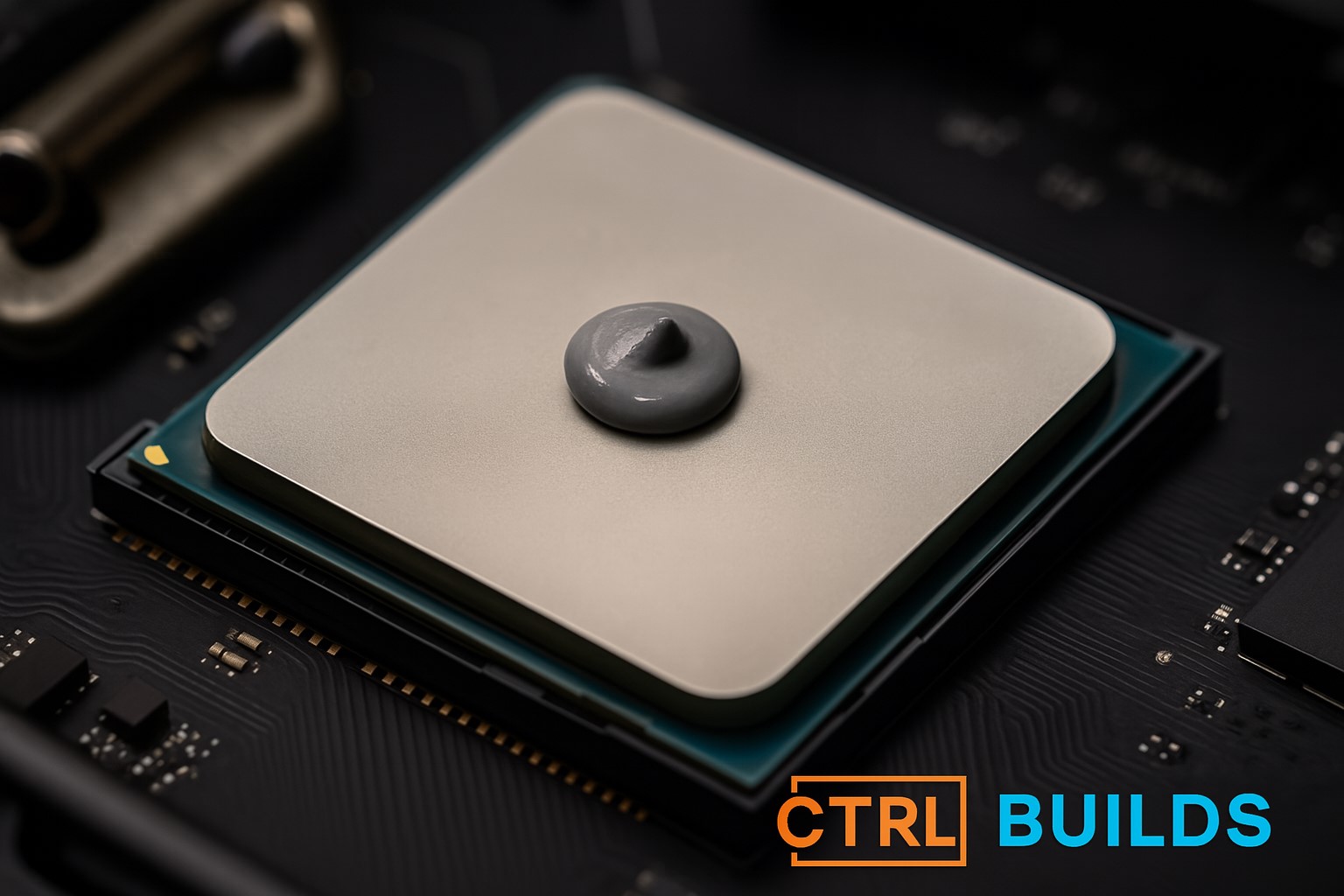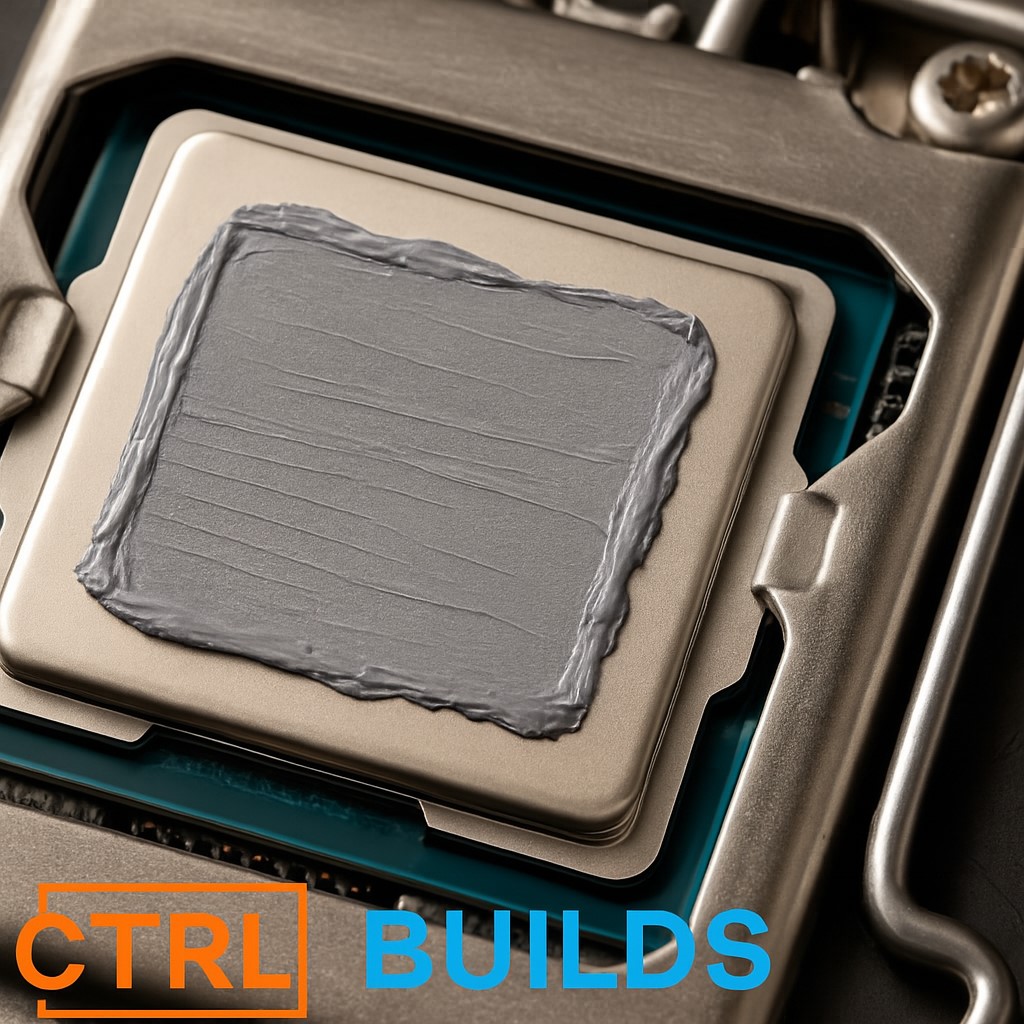What Does Thermal Paste Actually Do?
Thermal paste — also known as thermal compound or TIM (thermal interface material) — plays a vital role in any cooling setup. Its primary function is to fill microscopic gaps between your CPU’s integrated heat spreader (IHS) and the base plate of your cooler. These surfaces may appear smooth, but under a microscope, they contain tiny imperfections and air gaps — poor conductors of heat.
By spreading a thin, thermally conductive layer between the CPU and cooler, thermal paste ensures efficient heat transfer from the processor to the cooling solution. This helps maintain safe operating temperatures, improves system stability, and prolongs component lifespan — especially under load.
In real terms, a good thermal paste can reduce CPU temperatures by several degrees compared to budget or stock compounds. This becomes increasingly important for modern processors like the Intel Core i7-14700K or AMD Ryzen 7 7800X3D, which generate substantial heat during gaming, rendering, or heavy multitasking.
There are different types of thermal interface materials available, including:
- Standard pastes: The most common option, using a ceramic or metal-based compound to offer a balance of conductivity, ease of use, and affordability.
- Liquid metal: Extremely high thermal conductivity, but electrically conductive and risky for beginners — it can damage components if misapplied.
- Thermal pads: Pre-cut, solid-state materials that are cleaner to apply but typically less efficient than paste. More common in laptops and VRMs than on CPUs.
In the UK, thermal paste tends to be pre-applied on many budget coolers (like Cooler Master or DeepCool stock models), but for custom PC builders or upgraders, reapplying with a higher-quality product can improve both temps and noise levels. Whether you're building a new rig or re-seating an old cooler, knowing how thermal paste works — and choosing the right one — is essential for performance.
Performance Showdown
We’ve compiled real-world benchmark results from trusted UK and global reviewers — including Gamers Nexus, KitGuru, and Tom’s Hardware — all tested on modern CPUs like the Intel Core i7-13700K and AMD Ryzen 7 7800X3D. Conditions ranged between 20–24°C ambient, using both tower air coolers and 240–360mm AIOs.
The table below averages thermal performance, spread ease, and cleanup difficulty based on repeated third-party tests — giving you a realistic idea of how each paste performs in a typical UK gaming setup.
Thermal Paste Comparison Table
| Brand | Avg Load Temp | Spread Ease | Cleanup | UK Price | Notes |
|---|---|---|---|---|---|
| MX-6 | 63.4°C | Easy | Very easy | ~£5.50 (4g) | Balanced performance & value |
| Thermal Grizzly Kryonaut | 61.7°C | Moderate | Messy | ~£9.99 (1g) | Great for overclocking |
| Noctua NT-H2 | 62.2°C | Very easy | Easy | ~£8.95 (3.5g) | Consistent, no-fuss paste |
| Thermalright TF8 | 62.9°C | Easy | Moderate | ~£6.99 (2g) | Popular budget choice |
| Gelid GC-Extreme | 62.4°C | Moderate | Moderate | ~£5.25 (3.5g) | Used by LN2 overclockers |
| Cooler Master CryoFuze Violet | 64.1°C | Easy | Very easy | ~£4.99 (2g) | Stylish, decent for casual builds |
| Thermal Grizzly Conductonaut | 59.9°C | Tricky | Very messy | ~£9.49 (1g) | Liquid metal – expert use only |
While thermal differences between top pastes may only span 2–4°C, that margin can mean the difference between a CPU staying quiet — or thermal throttling under sustained load. In general, ease of use and price are just as important for the average UK builder as pure thermal performance.
Best Overall Picks for UK Builders
After comparing performance, price, ease of use, and availability in the UK, these are the standout thermal pastes we’d recommend for different types of PC builders in 2025:
- 💎 Best Overall: Noctua NT-H2 — Excellent thermal performance, super easy to apply, and widely available in multi-use packs.
- 💷 Best Budget Option: Arctic MX-6 — Great balance of performance and price (~£5 for 4g), with simple application and clean results.
- ⚙️ Best for Overclocking: Thermal Grizzly Kryonaut — Lower temps than most, trusted by pros, though slightly messier to handle.
- 🛡️ Best for Beginners: Cooler Master CryoFuze Violet — Forgiving spread, easy cleanup, and solid results for casual builders.
- ⚠️ Expert Use Only: Thermal Grizzly Conductonaut — Liquid metal gives the lowest temps, but is conductive and risky if mishandled. Not beginner-friendly.
For most UK builders, Noctua NT-H2 or Arctic MX-6 will do the job brilliantly without costing much — and they don’t require a PhD in application. If you're chasing every last degree, Kryonaut or even Conductonaut may be worth it, but only with proper prep and confidence.
Final Thoughts
In 2025, thermal paste isn’t just an afterthought — it’s a performance layer. With modern CPUs pushing higher wattages and UK ambient temperatures rising in summer, the paste you choose can have a real impact on stability, fan noise, and thermal headroom.
If you're upgrading your CPU, swapping coolers, or noticing temperature creep on an older rig, now’s the time to clean things up and reapply. Even high-end pastes degrade over time, especially if they were pre-applied by the manufacturer.
Here’s what matters most when picking a paste:
- Ease of application: If you’re new to building or don’t want the stress, go with a non-conductive paste that spreads easily.
- Thermal performance: Within 2–4°C across most premium pastes, so pick based on use-case (quiet vs max cooling).
- Cleanup: If you’re planning future upgrades, choose something that wipes clean without drama.
- UK pricing and availability: Stick to reputable brands — don’t risk knock-offs for a couple of quid saved.
Ultimately, the best paste is the one that gets the job done without stress. For most UK builds, a £5–£10 tube will last multiple installations and keep your CPU running safely through heatwaves, long gaming nights, and everything in between.
Stay cool, build sharp — CTRL your thermals.

